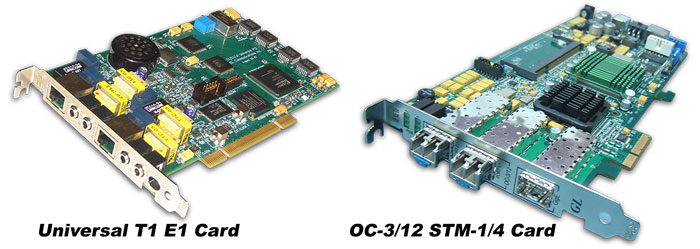Newsletter: GL Announces Linux Drivers & APIs
(And Throughs on the Open Source Paradigm Shift)
Welcome to another April 2011 issue of GL Communications' Newsletter providing information and insight into our newest Linux Driver & API Support for Universal T1 E1 and OC-3/12 STM-1/4 Cards.
Overview
The Internet as we know it today would not exist without "open source software", a model based on collaborative software development available free to anyone. Its roots are in academia, colleges, and universities where open and free exchange of ideas (and software) is a way of life. The Internet is powered by open source, like Linux, Apache, TCP/IP, DNS, PHP, the list is endless. Without open source, companies like Google and Yahoo wouldn't exist. In fact, every computer or communications company owes its life to open source software in one way or another. If you have a good idea, then the cost to execute is immensely cheaper. You can go one step further, the developing countries (lately developed!) like China, India, East Asia, and even the Middle East now, owe their emergence, and their greater freedom to open source software! Wow! What an impact this new paradigm has had
Linux is the shining star of open source. So GL is developing Linux drivers and APIs for our flagship products! Since our cards have unique features unavailable with other industry standard cards, customers can now build custom applications faster and cheaper. Currently, we have Linux drivers and APIs for our T1 E1 Universal and OC-3/12 STM-1/4 Cards. All of the functionality of the hardware is exposed through the API. In addition, many software based functions are available that ease even the most complex application development.
Here are some more examples of what you can do with these cards in Linux.

Details of Linux APIs and Drivers
- Having ported our "GLComIFC" from Windows to Linux, the driver and API expose all features of the hardware for both T1 E1 and OC-3/12 STM-1/4 Cards
- An API Toolkit provides examples how to access the Raw Data, Set / Reset Registers, Set Clocking Modes, Get / Set Alarms, Loopbacks
- For T1 E1 Universal Card, examples are provided for:
- Implementing HDLC on single timeslots or multitimeslot streams, ATM cell delineation and much more
- Implementing Delay and BERT, Record/Playback on sub-timeslot, timeslot, and multi-timeslot streams
- Working with multiple cards in a single PC, Implementation methods for Frame Relay in software, Accessing Pulse Mask and Jitter measurements, Dropping / Adding VF Input and VF Output
- Configuring special cabling options like Cross Port Thru, Cross Port Transmit, Bridge, and Monitor
- Access to Error Insertion Logic, Access to Tx Frequency Deviation Logic
- For OC-3/12 STM-1/4 (LightSpeed1000™ Card), examples are provided for:
- Works on Win32 and Linux with C/C++ interfaces (VS2005 and above for windows)
- Record / Playback at Wirespeed at (Gigabits/sec)!
- Scrambling / Non-scrambled payload management in ATM / POS / Transparent modes with Internal and Recovered Clock management
- Loopback Line / Diagnostic / PL3, Rx Terminate / Monitor support, ATM Idle Cell Control, Hardware Data Filters
- Hardware and Software Based Performance Counters, SFP Information, Alarm Monitoring (OOF, LOF, LOS, AIS, RDI, APSBF )
- ATM Error Counters ( BIP, REI, HEC ), POS Error Counters (BIP, REI, Rx/Tx abort, Min/Max length)
- Hardware BERT, POS FCS 32-bit, 16-bit and no-FCS support, POS Hardware Appending / Stripping FCS, Overhead Byte Configuration, Section and Line Error Counts, Insert HCS Errors
 Back to Latest News Page
Back to Latest News Page